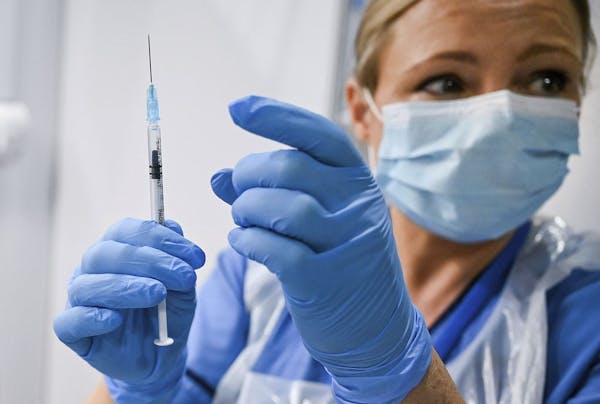At least 345,636 people have received first doses of COVID-19 vaccine in Minnesota, according to state figures released Friday, and 96,842 have completed the two-dose series.
The latest figures represent a one-day increase of nearly 37,000 doses administered in Minnesota, where state health officials took several steps in the last two weeks to get more COVID-19 vaccine out of freezers and into arms. Mass vaccinations continued Friday of nearly 10,000 seniors at nine state sites, and of 15,000 metro-area educators at Xcel Energy Center in St. Paul.
More than 6.3% of Minnesota's population has now at least received a first dose of vaccine against a novel coronavirus that has caused 459,747 known infections and 6,168 COVID-19 deaths in the state. That includes 28 deaths reported Friday and 1,145 infections verified through diagnostic testing.
Twenty-two of the deaths reported Friday involved people 65 and older, who have suffered 89% of the total COVID-19 deaths in Minnesota.
Eleven of the deaths involved long-term care residents who are at heightened risk of COVID-19 due to their ages and underlying health conditions. Seventeen involved residents in the seven-county Twin Cities region.
The state initially prioritized roughly 500,000 health care workers and long-term care residents for limited doses of COVID-19 vaccine, but has since expanded access to people 65 and older. More health systems such as Allina and M Health Fairview in Minneapolis started offering vaccine appointments to older patients while continuing to provide doses to health care workers.
State Health Commissioner Jan Malcolm said on Thursday that Minnesota remains on track to have at least offered or provided first doses of COVID-19 vaccine to the initial priority group by month's end.
Malcolm said no decisions have been made yet on whether special vaccination events at nine state sites will continue next week and offer more first doses for senior citizens. All sites will continue to offer scheduled second shots, though. More than 200,000 people registered for vaccination at these sites this week, but less than 10,000 received appointments via a random drawing.
Malcolm said the sites were a test in some ways of Minnesota's ability to quickly assemble mass vaccination events as needed. The overriding plan remains to use existing health care providers to administer vaccine throughout the state, she said.
Gov. Tim Walz on Thursday said that Minnesota has a "golden opportunity," because vaccine supplies are increasing as other measures of pandemic severity are improving in the state. The positivity rate of COVID-19 diagnostic testing has now dropped to 4.8%, which is below the 5% state warning threshold and indicates reduced spread of the virus.
Minnesota hospitals as of Thursday reported total admissions of 450 COVID-19 patients, including 95 who needed intensive care. That is the lowest total of COVID-19 hospitalizations since mid-October.
Walz and Malcolm on Thursday urged people to be patient as they await vaccine but acknowledged the frustration of some groups who have yet to receive access.
The initial federal vaccine guidance was to start with health care workers and long-term care residents; then to move on to people 75 and older and workers in essential front-line industries; then to move on to other critical workers as well as people 65 and older and younger adults with underlying health problems.
Some outpatient providers in the first group such as dentists have yet to be approached. And while some teachers have received vaccine, other front-line workers in the second group are still waiting. Seniors citizens also have received access while younger adults with severe health problems have not.
Malcolm said the federal government has been unclear about whether states should expand vaccine access to the younger chronically ill population at the same time as senior citizens, but that Minnesota is looking to do that — starting with the conditions that have the worst impact on COVID-19.
"We're trying to work through the data now to identify which conditions are most significant from a COVID morbidity perspective," she said.
Jeremy Olson • 612-673-7744

Minneapolis schools, teachers reach tentative agreement to avert strike
Men knock woman down and steal her dog during walk, St. Paul police say

Minneapolis reaches $150k settlement with eyewitness of George Floyd's murder
He grew up legally in Minnesota, but immigration law gap may one day force student to leave

